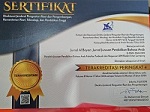Bahrain Meaning in the Story of Musa and Khidr
Abstract
In surah Al-Kahf verses 60-82, the term bahrain has a deeper connotation than its lexical sense. It is because the passage is linked to the story of Musa and Khidr. The two prophets reflect the several types of knowledge that the term bahrain encompasses. This research aims to examine and uncover the meaning of the word bahrain. This study employed a semiotic approach and a qualitative descriptive research method. The stages in analyzing the data are isytiqaq kabir, syntagmatic-paradigmatic, and semiotics analysis. Isytiqaq kabir was adopted to determine the denotative meaning of the Bahrain word. Syntagmatic-paradigmatic analysis was employed to explain the valence of the bahraini. Semiotics was adopted to analyze the signs in the verses that build meaning. Based on the isytiqaq kabir analysis, the term bahr signifies sea, honor, a prominent position, knowledge, benefit, and being generous. Meanwhile the result of syntagmatic-paradigmatic analysis, bahrain has two seas of knowledge: rational and intuitive knowledge. After going through three stages of linguistic analysis, Allah instructs Musa to learn from Khidr so that he can be wiser in dealing with his people. This research contributes to the treasures of new interpretations of the Qur'anic verses using linguistic concepts and theories.
Keywords
Full Text:
PDFReferences
Ahmad, Ahamd. “Analisis Kasus Pembunuhan Anak Kecil Dalam Kisah NAbi Khidr Perspektif Politik Hukum MAchiavelli Dan Sad Adz-Dzari’ah.” Al-’Adalah: Jurnal Syariah dan Hukum Islam 5, no. 1 (2020): 14–34.
Ahmad, Ahmad. “Mempelajari Misteri Ilmu Khidr Dalam Era Millenial (Analisis Kontroversi Gus Dur Perspektif Ilmu Khidr).” Syaikhuna: Jurnal Pendidikan dan Pranata Islam 10, no. 1 (2019): 105–125.
Ahmed, Mohamed Aziz Abdelmaksoud Sayed, Ragab Ibrahim Ahmed Awad, and Elsayed Mohamed Salem Alawadi. “The Contributions of Ibn Jinni in the Science of Arabic Prosody and Rhyme.” IJAS: Indonesian Journal of Arabic Studies 3, no. 1 (2021): 1–18.
Al-Asqalani, Ahmad Ibn Ali Ibn Hajar. Az-Zahru An-Nadhar Fi Hal Al-Khidr. Edited by Sholahudin Maqbul Ahmad. 2nd ed. (Kuwait: Maktabah Ahlu Al-Watsr, 2004).
Al-Ghalayain, Musthafa, Jami’ Ad-Durus Al-Arabiyah. Lebanon: Dar El-Fikr, 2007.
Al-Harowi, Ali bin Sulthan Muhammad Al-Qori, Al-Hadzaru Fi Amr Al-Khadir. Edited by Muhammad Khoir Ramadhan Yusuf. I. Damaskus: Dar Al-Qolam, 1991.
Al-Khalidi, Sholah Abdu Al-Fatah, I’jaz Al-Qur’an Al-Bayani Wa Dalail Masdaruh Ar-Rabbani. I. Oman: Dar Al-Amar, 2000.
Al-Mahdi, Jaudah Muhammad Abu Yazid. Al-Ma’alim As-Shufiyah Fi Qissoh Sayyidina Musa Wa Khidr ’Alaihimassalam. Tonto-Mesir: Fakultas Al-Qur’an Al-Karim, n.d.
Al-Maraghi, Ahmad Musthafa, Tafsir Al-Maraghi. 1st ed. Mesir: Musthafa Al-Bab Al-Halabi Wa Auladuh, 1946.
Alghiffary, Muhammad, “Pemikiran Tokoh-Tokoh Bahasa Arab.” In Kontribusi Ibnu Jinni Dalam Perkembangan Linguistik Arab, 46. Yogyakarta: Trussmedia Grafika, 2018.
As-Samak, Ahmad Zain Al-Abidin, Rihlah Min Ajli Al-’Ilm Musa Wa Al-Khidr. 2nd ed., 1989.
As-Samirai, Fadil Shalih, Balaghah Al-Kalimat Fi At-Ta’bir Al-Qur’ani. Baghdad: Maktabah An-Nahdah, 2006.
As-Syaikhali, Bahjah Abd Al-Wahid, Balaghah Al-Qur’an Al-Karim I’roban Wa Tafsiran Bi Ijazin. I. Oman: Maktabah Dandis, 2001.
Asad, Muhammad, The Message of The Qur’an. Gibraltar: Dar Al-Andalus, 1984.
Asy-Sya’rowi, Muhammad Mutawali, Tafsir Asy-Sya’rowi. Mesir: Dar Akhbar Al-Yaum, 1991.
Asykur, Muamar, Muhammad Tang, and Ismail Ismail. “Prophetic Education Management Paradigm; Construction of Planning Narratives in the Story of Prophet Musa and Prophet Khidr.” Al-Tanzim: Jurnal Manajemen Pendidikan Islam 6, no. 1 (2022): 105–117.
Aufi, Ahmad Umam. “The Story of Musa and Pharaoh in a Structural Anthropology Approach.” Jurnal Ushuluddin 29, no. 1 (2021): 45–59.
Az-Zamakhsyari, Abu Al-Qasim Jarallah Mahmud bin Umar, Tafsir Al-Kasyaf. 3rd ed. Beirut-Lebanon: Dar Al-Marefah, 2009.
Bakhtiyorovna, Norova Mekhri, and Barotova Zamira. “Semiotics in the Field of Literature.” In “ Online-Conferences” Platform, (2021): 204–207.
Baqi, Muhammad Fuad Abdul, Al-Mu’jam Al-Mufahros Li Al-Fadz Al-Qur’an Al-Karim. Kairo: Matba’ah Dar Al-Kutub Al-Misriyah, 1943.
Dakake, Maria Massi. “Ta’wīl in the Qur’an and the Islamic Exegetical Tradition: The Past and the Future of the Qur’an.” In The Enigma of Divine Revelation, (2020): 237-259.
Eco, Umberto, Teori Semiotika Signifkansi Komunikasi, Teori Kode, Serta Teori Produksi Tanda. Translated by Inyiak Ridwan Muzir. VI. Bantul: Kreasi Wacana, 2016.
Everaert-Desmedt, Nicole, “Peirce’s Semiotics.” In An Introduction to Applied Semiotics (2019): 241-249.
Faez, Qasem, and Khadijeh Masroor. “Great Derivation, Ishtiqaqi Kabir, in the Holy Quran and Its Role in Exegesis.” Journal of The Holy Quran And Islamic Texts 9, no. 35 (2018): 145–168.
Fatoni, Muhamad, Mujamil Qomar, and Syamsun Ni’am. “Laduni Science According to Muhammad Luthfi Ghozali’s Thoughts.” International Journal of Social Science and Education Research Studies 2, no. 6 (2022): 171–178.
Gorter, Durk. “Methods and Techniques for Linguistic Landscape Research: About Definitions, Core Issues and Technological Innovations.” Expanding the linguistic landscape: Multilingualism, language policy and the use of space as a semiotic resource 38 (2018): 57.
Hermansyah, Sunandar Alwi, Yeni Ratna Yuningsih, Sri Mulyati, Ahmad Syahid, and Zainun Kamaluddin Faqih. “Knowledge of Ladunni in the Story of Musa and Khidhir in the Review of Isyari Shufi’s Interpretation.” In ICIIS 2020: Proceedings of the 3rd International Colloquium on Interdisciplinary Islamic Studies, (2020): 145.
Holliday, Adrian, and Malcolm N Macdonald. “Researching the Intercultural: Intersubjectivity and the Problem with Postpositivism.” Applied Linguistics 41, no. 5 (2020): 621–639.
Ibad, Yuli Irsyadul. “Uslub Dialogis Kisah Nabi Musa As. dalam Al-Qur’an.” Al-Fathin: Jurnal Bahasa dan Sastra Arab 3, no. 1 (2020).
Irshad, Sadia, Sadia Arshad, and Kaukab Saba. “Lexicogrammatical Features of Covid-19: A Syntagmatic and Paradigmatic Corpus Based Analysis.” CORPORUM: Journal of Corpus Linguistics 4, no. 2 (2021): 76–94.
Izutsu, Toshihiko. Sufisme Samudra Makrifat Ibn ’Arabi. Translated by Musa Kazhim and Arif Mulyadi. 2nd ed. Bandung: PT Mizan Publika, 2016.
Jahanbakhsh, Forough. “The Pir-Murid Relationship in the Thought of Ayn Al-Qudāt Hamadāni.” In Consciousness & Reality: Studies in Memory of Toshihiko Izutsu (2022): 130.
Jandra, Mifedwil, Anhar Anshori, H M Kholili, and Arif Rahman. “Oceanic Verses of the Qur’an and Their Pointers To Technological Solutions.” Heritage of Nusantara: International Journal of Religious Literature and Heritage 8, no. 2 (2019): 243–268.
Jia, Hongwei. “Signs, Language, and Listening: A Review: Review of Signs, Language and Listening: Semioethic Perspectives, by Susan Petrilli.” The American Journal of Semiotics 35, no. 3/4 (2020): 463–473.
Kasri, Linda, Moh Khasairi, and Ali Ma’sum. “Isim Maushul Dalam Al-Qur’an Surat Al-KahfKajian Sintaksis Dan Semantik.” In Prosiding Konferernsi Nasional Bahasa Arab IV (2018): 612-623.
Katsir, Ismail Ibn Umar Ibn. Tafsir Al-Qur’an Al-’Adzim. Edited by Sami Ibn Muhammad Ibn Salamah. 2nd ed. Mekah: Dar Thoyyibah Li an-Nasr wa at-Tauzi’, 1999.
Khalil, Mohammad Hassan. Islam dan Keselamatan Pemeluk Agama Lain. Translated by Chandra Utama. 1st ed. Bandung: Penerbit Mizan, 2016.
Kozintsev, Alexander. “Communication, Semiotics, and the Language Rubicon.” Russian Journal of Communication 10, no. 1 (2018): 1–20.
Kurdi, Hermeneutika Al-Qur’an Dan Hadis. 1st ed. Yogyakarta: El Saq, 2010.
Lajnah min Al-’Ulama. At-Tafsir Al-Wasith Li Al-Qur’an Al-Karim. III. Al-Mushaf As-Syarif, 1992.
Mandur, Ibnu. Lisan Al-Arab. Kairo: Dar Al-Ma’arif, n.d.
Mantasiah, R. “Semantic Feature Analysis Model: Linguistics Approach in Foreign Language Learning Material Development.” International Journal of Instruction 13, no. 1 (2020): 185–196.
McDonald, Edward. “Syntagmatic and Paradigmatic Relations: Structure and System.” In Grammar West to East (Springer, 2020): 217-226.
Mohajan, Haradhan Kumar. “Qualitative Research Methodology in Social Sciences and Related Subjects.” Journal of Economic Development, Environment and People 7, no. 1 (2018): 23–48.
Moloeng, Lexy J. Metodologi Penelitian Kualitatif: Edisi Revisi. Bandung: Rosda, 2010.
Munawwir, Ahmad Warson. Al Munawwir Kamus Arab-Indonesia. Surabaya: Pustaka Progressif, 1997.
Mushodiq, Muhamad Agus, and Wahyudi Wahyudi. “Characteristics of Sufi Al-Sulamy’s Tafsir Method: A Case Study of The Prophet of Musa And Khidr.” Jurnal At-Tibyan: Jurnal Ilmu Alqur’an dan Tafsir 5, no. 2 (2020): 213–239.
Narimani, Zohreh, Jafar Firoozmandi Bandpey, and Zahra Javadi Nasr. “Explaining the Quiddity of Prophet Khidr (PBUH) with the Focus on Interpretive Analysis of Verses 60 to 82 of Surah Al-Kahf and Removing Doubts About It.” International Journal of Multicultural and Multireligious Understanding 8, no. 10 (2021): 41.
Nasir, Jamal Abd. “Nilai-Nilai Pendidikan Karakter Guru Dan Murid Dalam Perspektif Kisah Musa Dan Khidr Dalam Surat Al-KahfAyat 60-82.” Nuansa 15, no. 1 (2018): 173–194.
Nikoui, Mojgan, Alireza Ghoujezadeh, Masoumeh Khodadadi Mahabadi, and Fatemeh Kakavand Qalenoui. “A Conceptual Correspondence of the Symbol of Fish in Mythology, Holy Quran and Masnavi and Its Application in Artworks.” Islamic Art Studies 15, no. 36 (2020): 259–278.
Nimah, Jamilatun, Muhammad Hanif, and Ika Anggraheni. “Nilai-Nilai Pendidikan Islam Dalam Kisah Nabi Khidr Dan Nabi Musa (Telaah QS Al-Kahfi: 60-82).” Vicratina: Jurnal Pendidikan Islam 4, no. 4 (2019): 168–180.
Nurahmadqizi, Khamidova Nargiza. “The Development of a Semiotic Point of View in Structural Linguistics.” European Multidisciplinary Journal of Modern Science 4 (2022): 545–547.
Partanto, Pius A, and M Dahlan Al Barry. Kamus Ilmiah Populer. Surabaya: Arkola, 2001.
Qosimova, M B. “The Formation of Language as a System.” Journal of Pedagogical Inventions and Practices 7 (2022): 207–208.
Rajih, Muhammad Karim. Mukhtasor Tafsir Ibn Katsir Tafsir Al-Qur’an Al-Adzim. Beirut-Lebanon: Dar Al-Ma’rifah, 1999.
Ramadhani, Ahmad. “Teacher and Student Relationship in The Story of Musa And Khidr.” Sunan Kalijaga International Journal on Islamic Educational Research 5, no. 2 (2021): 1–14.
Rifai, Sulaiman Lebbe. “The Sufi Influence on the Qur’anic Interpretation.” (2021): 1-15.
Salam Abbood Hasan. “The Manners of The Seeker of Knowledge in Light of the Story of Musa And Al-Khidr In Surat Al-Kahf.” Journal of Natural Remedies 21, no. 7 (2020): 130–142.
Shihab, Muhammad Quraish. Tafsir Al-Misbah Pesan, Kesan Dan Keserasian Al-Qur’an. 8th ed. Jakarta: Lentera Hati, 2005.
Simuh. Sufisme Jawa Transformasi Tasawuf Islam Ke Mistik Jawa. 4th ed. Yogyakarta: Yayasan Bentang Budaya, 1999.
Siregar, Iskandarsyah. “Semiotic Touch in Interpreting Poetry.” Britain International of Linguistics Arts and Education (BIoLAE) Journal 4, no. 1 (2022): 19–27.
———. “Semiotics Analysis in The Betawi Traditional Wedding" Palang Pintu": The Study of Semiotics Roland Barthes.” International Journal of Linguistics Studies 2, no. 1 (2022): 1–7.
Sobur, Alex. Semiotika Komunikasi. Bandung: Remaja Rosdakarya, 2006.
Taguchi, Naoko. “Description and Explanation of Pragmatic Development: Quantitative, Qualitative, and Mixed Methods Research.” System 75 (2018): 23–32.
Tamtam, Hamza Elhadi Mohamad. “The Impact of the Figure of Khidr on Medieval Sūfī Thought.” England: University of Birmingham, 2019.
Younesie, Mostafa. “Minima Onomastica Graeca Alpharabia: Notes on the Treatise" Tafsir Asma Al-Hukama".” Collectanea Philologica 24, no. 1 (2021): 127–140.
Zhao, Yiheng. “Redefining Sign/Symbol and Semiotics.” In The River Fans Out (2020): 3-14.
Zikrillah, Abdu, and Ihsan Sa’dudin. “Kajian Semiotika Poster Kegiatan Frankfurt 63rd International Motor Show.” ORASI: Jurnal Dakwah dan Komunikasi 10, no. 2 (2019): 247.
Zulyeno, Bastian. “The Position of Water and River in Classical Persian Literature.” International Review of Humanities Studies 4, no. 2 (2019).
DOI: http://dx.doi.org/10.24042/albayan.v14i1.11580
Refbacks
- There are currently no refbacks.
Copyright (c) 2022 Jurnal Al Bayan: Jurnal Jurusan Pendidikan Bahasa Arab
License URL: https://creativecommons.org/licenses/by-sa/4.0
Editorial Office:
Jurnal Al Bayan: Jurnal Jurusan Pendidikan Bahasa Arab, Arabic Education Study Program, Faculty of Education and Teachers Training, Unversitas Islam Negeri Raden Intan Lampung
Jl. Endro Suratmin 1 Sukarame, Bandar Lampung 35131-Indonesia
e-mail: jurnalalbayan@radenintan.ac.id
http://ejournal.radenintan.ac.id/index.php/albayan/index
Jurnal Al Bayan: Jurnal Jurusan Pendidikan Bahasa Arab is licensed under a Creative Commons Attribution-ShareAlike 4.0 International License. p-ISSN 2086-9282 | e-ISSN 2549-1229









